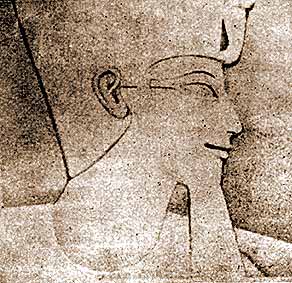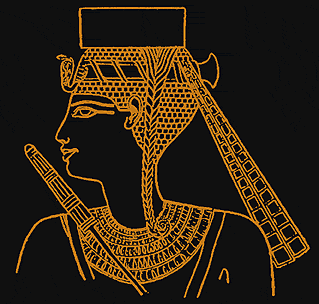|
Portrayed by some authors
as a rather sickly king constantly overshadowed by his queen,
a future king of Egypt, Hatshepsut (there does seem to be very
little evidence, if any, to support this assumption. It probably
has more to do with the standard theory of Hatshepsut of being
the 'first wicked stepmother' in history!). However, little remains
from the reign of Tuthmosis II; he did mount at least military
campaign against the Asiatics and entered Syria with the Egyptian
army. Another campaign is also recorded in this reign - a campaign
into Nubia, although this campaign is recorded as being fought
by his commanders in the name of Tuthmosis II.
Building
work of Tuthmosis II
He built mainly at the temple of Amun, Karnak - here he began
work on pylon IX, two statues in front of this pylon are of Tuthmosis
II. Several chambers were also decorated by Tuthmosis II and
Hatshepsut - in some cases the decoration of Tuthmosis II has
been usurped by Hatshepsut.
|
 |
Queens
of Tuthmosis II
Hatshepsut (his Chief Queen and half-sister),
Isis (probably not of royal blood, possibly a woman from his
harem) who bore a daughter Neferu-re (the eldest child, she was
not live much longer than her 16th year (Senmut, courtier of
Hatshespsut, was named as Keeper of Her Palace), her title is
given as 'Lady of Both Lands, Princess of the North and South')
and a son; Tuthmosis III (declared heir to the throne before
the death of Tutmosis II).
 Neferu-re
Neferu-re
Other information from the reign of Tuthmosis II comes from the
royal architect Ineni (the same Ineni who orginally thought of
burying Tuthmosis I in the Valley of the Kings). Ineni would
remain in favour in royal circles for a little while longer -
he also records how he was highly thought of by the King Hatshepsut.
The tomb
of Tuthmosis II
Although
not positively identified, there is a tomb in the Valley of the
Kings that remains favourite for the tomb of Tuthmosis II. KV42
has an oval or cartouche-shaped burial chamber (similar in shape
to the shape of tombs under Tuthmosis III), and holds a sarcophagus
- however the tomb itself is unfinished without decoration, the
sarcophagus is unpolished and undecorated. A burial is known
to have been placed within KV42, pots and other burials items
have been found - does the unfinished appearance indicate an
untimely death of Tuthmosis II hastily buried? No other tomb
has yet to be discovered which may be identified with him. His
mummy
and coffin
was found within the mummy cache of TT320.
|



